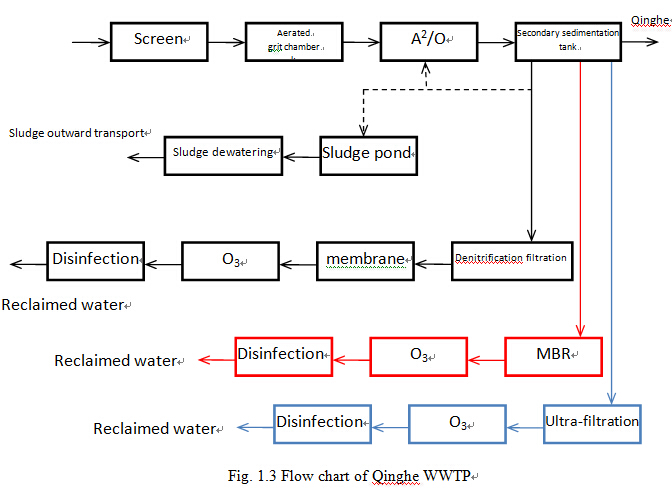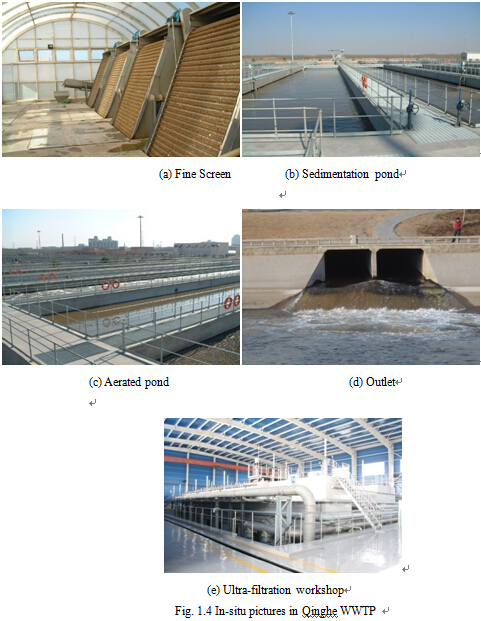Qinghe Wastewater Treatment Plant
chinagate.cn, March 22, 2015 Adjust font size:
Beijing Municipal Research Institute of Environmental Protection recently issued a survey report entitled "Technical report on typical wastewater treatment in North China". The research team carried out the investigation of wastewater treatment technologies in Beijing and Hebei provinces that may be suitable for adoption in Africa.
The investigation consists of field research and information provided by company, focusing on the wastewater treatment process, investment costs, operating costs, treatment capacity, occupation area, inflow conditions and water quality and other aspects.
Qinghe WWTP is located in Ma Fangcun village, Qinghe town, Haidian District in Beijing with an occupation area of 30.1 hectares and service area of 15,942 hectares and population of 814,000. Wastewater is mainly from the western suburbs landscape, cultural and educational areas, Zhongguancun science and technology Park, and the Qinghe industrial park. At the same time, Qinghe WWTP is also responsible for improving downstream water quality.
The total investment of WWTP is 717 million RMB with two periods of infrastructure construction. The total wastewater treatment capacity is 400,000 tons daily. The first period of the project was completed in October 2002 and put into operation with daily treatment capacity of 200,000 tons and inverted A2/O technology. The second period of the project was completed in December 2004 and put into operation with designed daily treatment capacity of 200,000 tons and A2/O technology with energy consumption of 0.25 to 0.3 kWh of electricity per ton of water. In order to alleviate the problem of insufficient wastewater treatment capacity, expansion project with 150,000 tons capacity was also completed. Currently the treated wastewater quality can achieve GB18918-2002 B standards.
The Qinghe wastewater treatment plant has started to reclaim water for reuse. MBR + ozone technology (150,000 m3/day), denitrification biofilter and film treatment and ozone treatment technology (320,000 m3/day), and UF + ozone technology (80,000 m3/day) are adopted for water reclaiming, which can provide at least 200 million tons of landscape water annually for the Olympic Park and other places. The system with MBR and O3 technology has an operating cost of 0.1RMB/ ton higher than the cost of traditional technology for effluent water quality meeting the national level A standard. The effluent water quality is based on city reclaimed water standard for miscellaneous water and landscape environment water uses as shown in table 1.3.
Excess sludge is pumped to storage pond with the sludge pump. After being pressured, excess sludge is concentrated and dewatered by a screw press. The sludge cake is further treated by sludge drying in the WWTP. Moisture content of sludge cake can be decreased from 80% to 10%. Dried sludge can be utilized as a resource such as fuel, fertilizer, construction material etc.
Table 1.3 Discharge standard of Qinghe reclaimed water treatment plant with MRR and O3 technology
(GB/T 18920-2002&GB/T 18921-2002)
|
Parameter |
Aesthetic environment use |
Entertainment environment use |
City miscellaneous water or wastewater reclaimed and reused |
||||||||
|
River |
Lake |
Landscape |
River |
Lake |
Landscape |
Toilet washing |
Road washing and extinguishing |
Greening |
Car washing |
Construction |
|
|
DO |
1.5 |
2 |
1 |
||||||||
|
BOD5 |
10 |
6 |
6 |
10 |
15 |
20 |
10 |
15 |
|||
|
SS |
20 |
10 |
No demand |
- |
|||||||
|
TN |
15 |
- |
|||||||||
|
NH3-N |
5 |
10 |
10 |
20 |
10 |
20 |
|||||
|
TP |
1.0 |
0.5 |
1.0 |
0.5 |
- |
||||||
|
Turbidity |
|
5 |
5 |
10 |
10 |
5 |
20 |
||||


